Related Research Articles

New Orleans is a consolidated city-parish located along the Mississippi River in the southeastern region of the U.S. state of Louisiana. With a population of 383,997 according to the 2020 U.S. census, it is the most populous city in Louisiana and the French Louisiana region; the third-most populous city in the Deep South; and the twelfth-most populous city in the southeastern United States. Serving as a major port, New Orleans is considered an economic and commercial hub for the broader Gulf Coast region of the United States.
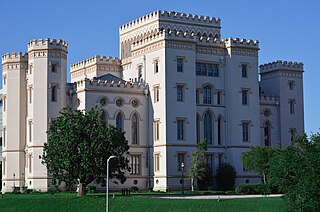
Baton Rouge is the capital city of the U.S. state of Louisiana. It had a population of 227,470 at the 2020 census, making it Louisiana's second-most populous city. It is the seat of Louisiana's most populous parish, East Baton Rouge Parish, and the center of Louisiana's second-largest metropolitan area, Greater Baton Rouge, which had 870,569 residents in 2020.

Jefferson Parish is a parish in the U.S. state of Louisiana. As of the 2020 census, the population was 440,781. Its parish seat is Gretna, its largest community is Metairie, and its largest incorporated city is Kenner. Jefferson Parish is included in the Greater New Orleans area.

Hammond is the largest city in Tangipahoa Parish, Louisiana, United States, located 45 miles (72 km) east of Baton Rouge and 45 miles (72 km) northwest of New Orleans. Its population was 20,019 in the 2010 U.S. census, and 21,359 at the 2020 population estimates program.
In United States local government, a consolidated city-county is formed when one or more cities and their surrounding county merge into one unified jurisdiction. As such it is a type of unitary authority that has the governmental powers of both a municipal corporation and a county.
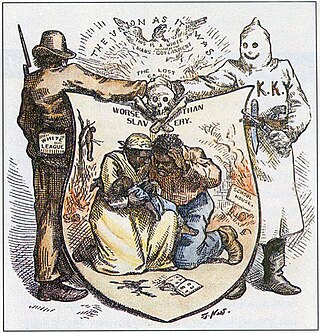
The White League, also known as the White Man's League, was a white supremacist paramilitary terrorist organization started in the Southern United States in 1874 to intimidate freedmen into not voting and prevent Republican Party political organizing, while also being supported by regional elements of the Democratic Party. Its first chapter was formed in Grant Parish, Louisiana, and neighboring parishes and was made up of many of the Confederate veterans who had participated in the Colfax massacre in April 1873. Chapters were soon founded in New Orleans and other areas of the state.

The New Orleans metropolitan area, designated the New Orleans–Metairie metropolitan statistical area by the U.S. Office of Management and Budget, or simply Greater New Orleans, is a metropolitan statistical area designated by the United States Census Bureau encompassing seven Louisiana parishes—the equivalent of counties in other U.S. states—centered on the city of New Orleans. The population of Greater New Orleans was 1,271,845 in 2020, up from 1,189,166 at the 2010 United States census. Greater New Orleans is the most populous metropolitan area in Louisiana, and the 45th most populous in the United States. According to 2017 census estimates, the broader New Orleans–Metairie–Slidell combined statistical area (CSA) had a population of 1,510,562.
The Coushatta massacre (1874) was an attack by members of the White League, a white supremacist paramilitary organization composed of white Southern Democrats, on Republican officeholders and freedmen in Coushatta, the parish seat of Red River Parish, Louisiana. They assassinated six white Republicans and five to 20 freedmen who were witnesses.

The New Orleans massacre of 1866 occurred on July 30, when a peaceful demonstration of mostly Black Freedmen was set upon by a mob of white rioters, many of whom had been soldiers of the recently defeated Confederate States of America, leading to a full-scale massacre. The violence erupted outside the Mechanics Institute, site of a reconvened Louisiana Constitutional Convention. According to the official report, a total of 38 were killed and 146 wounded, of whom 34 dead and 119 wounded were Black Freedmen. Unofficial estimates were higher. Gilles Vandal estimated 40 to 50 Black Americans were killed and more than 150 Black Americans wounded. Others have claimed nearly 200 were killed. In addition, three white convention attendees were killed, as was one white protester.

The Louisiana Constitution is legally named the Constitution of the State of Louisiana and commonly called the Louisiana Constitution of 1974, and the Constitution of 1974. The constitution is the cornerstone of the law of Louisiana ensuring the rights of individuals, describing the distribution and power of state officials and local government, establishes the state and city civil service systems, creates and defines the operation of a state lottery, and the manner of revising the constitution.
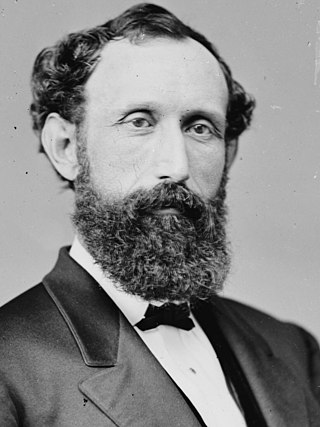
William Pitt Kellogg was an American lawyer and Republican Party politician who served as the governor of Louisiana from 1873 to 1877 and twice served as a United States senator during the Reconstruction era.
More than 1,500 African American officeholders served during the Reconstruction era (1865–1877) and in the years after Reconstruction before white supremacy, disenfranchisement, and the Democratic Party fully reasserted control in Southern states. Historian Canter Brown Jr. noted that in some states, such as Florida, the highest number of African Americans were elected or appointed to offices after the end of Reconstruction in 1877. The following is a partial list of notable African American officeholders from the end of the Civil War until before 1900. Dates listed are the year that a term states or the range of years served if multiple terms.

Henry Clay Warmoth was an American attorney and veteran Civil War officer in the Union Army who was elected governor and state representative of Louisiana. A Republican, he was 26 years old when elected as 23rd Governor of Louisiana, one of the youngest governors elected in United States history. He served during the early Reconstruction Era, from 1868 to 1872.

Louisiana was a dominant population center in the southwest of the Confederate States of America, controlling the wealthy trade center of New Orleans, and contributing the French Creole and Cajun populations to the demographic composition of a predominantly Anglo-American country. In the antebellum period, Louisiana was a slave state, where enslaved African Americans had comprised the majority of the population during the eighteenth-century French and Spanish dominations. By the time the United States acquired the territory (1803) and Louisiana became a state (1812), the institution of slavery was entrenched. By 1860, 47% of the state's population were enslaved, though the state also had one of the largest free black populations in the United States. Much of the white population, particularly in the cities, supported slavery, while pockets of support for the U.S. and its government existed in the more rural areas.
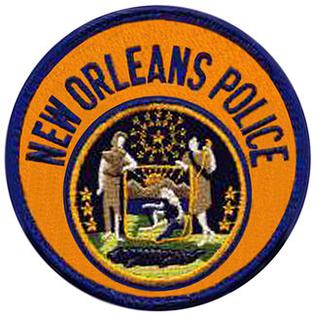
The New Orleans Police Department (NOPD) has primary responsibility for law enforcement in New Orleans, Louisiana, United States. The department's jurisdiction covers all of Orleans Parish, while the city itself is divided into eight police districts.

The Wheeler Compromise, sometimes known as the Wheeler Adjustment, was the settlement of the disputed gubernatorial election of 1872 in the U.S. state of Louisiana, and negotiation to organize the state's legislature in January 1875. It was negotiated by, and named after, William A. Wheeler, Congressman from New York and a member of the U.S. House Committee on Southern Affairs. He later was elected as Vice President of the United States.
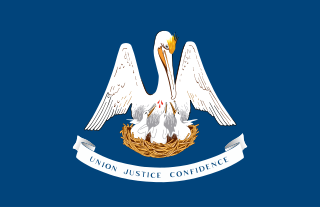
The following outline is provided as an overview of and topical guide to the U.S. state of Louisiana:
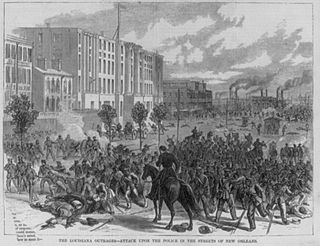
The Battle of Liberty Place, or Battle of Canal Street, was an attempted insurrection by the Crescent City White League against the Reconstruction Era Louisiana Republican state government on September 14, 1874, in New Orleans, which was the capital of Louisiana at the time. Five thousand members of the White League, a paramilitary organization made up largely of Confederate veterans, fought against the outnumbered racially integrated New Orleans Metropolitan Police and state militia. The insurgents held the statehouse, armory, and downtown for three days, retreating before arrival of federal troops that restored the elected government. At least 32 people, including at least 21 members of the White League, were killed in the fighting. No insurgents were charged in the action.
John Robert Graham Pitkin, also known as John R. G. Pitkin, was an American diplomat and soldier.
References
- 1 2 "New Orleans Metropolitan Police (1868-1877) @ Media Nola". medianola.org. Tulane University. Archived from the original on November 7, 2017. Retrieved 2017-11-04.
{{cite web}}: CS1 maint: unfit URL (link) - ↑ Leovy, Henry (1870). The laws and general ordinances of the city of New Orleans, together with the acts of the legislature, decisions of the Supreme Court, and constitutional provisions, relating to the city government, revised and digested, pursuant to an order of the Common Council. p. 325.